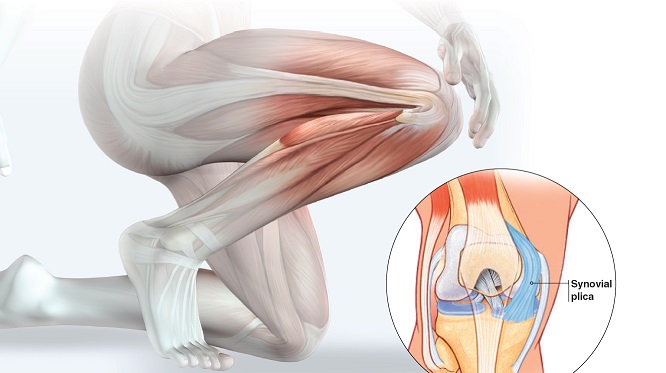What Is Plica Syndrome?
This irritating knee issue can be hard to pinpoint but fairly simple to manage.

Clients sometimes experience general pain in the knee during or after an exercise session, and while it’s not within your scope of practice to diagnose, a broad understanding of issues that affect this important joint can be helpful. Here’s a snapshot of plica syndrome.
Plica is a fold of synovial tissue that’s a “remnant” of embryologic development. The knee is initially divided into three compartments by membranes, which are then resorbed by the third or fourth month of fetal life (Scuderi et al. 1997). In up to 60% of people, however, this doesn’t happen. While that will not always cause problems, sometimes it will.
In short: Of the adults with this unabsorbed membrane around the knee (usually mediopatellar), a few will face discomfort:
- pain in the front of the knee, often toward the inside, especially with kneeling, squatting or rising from a seated position
- catching, locking and clicking
- pain and tenderness under the kneecap
- inflammation and tightness
How to Help Clients
If you suspect a client has plica syndrome, refer him or her to a qualified medical professional and follow the professional’s advice. Also, reassess the client’s biomechanics and review your programming. Revise it to include activities that are less likely to irritate and inflame the plica. Mike Bracko, PhD, a Calgary, Alberta—based exercise physiologist, advises avoiding repetitive-knee-flexion pursuits like running, biking, elliptical training or stair climbing. “It’s important to maintain quad strength, however,” says Bracko. “Program light-weight, half-range-of-motion (45-degree) squats or lunges (closed-chain exercises), 10 repetitions, 1–2 sets.”
Also, as part of a corrective-exercise program, look for muscular imbalances in the quadriceps and hips, as well as compromised mobility.
Reference
Scuderi, G.R., McCann, P.D., & Bruno, P.J. 1997. Sports Medicine: Principles of Primary Care. St. Louis: Mosby.
Welcome to IDEA Body Lab!
Each issue, this new column will highlight an unusual or esoteric fact about the body, along with clear, expert advice about its relevance to fitness professionals. If you’d like to share a fun fact about anatomy, biomechanics or one of the body’s main systems, contact content@ideafit.com.
Welcome to IDEA Body Lab!
Each issue, this new column will highlight an unusual or esoteric fact about the body, along with clear, expert advice about its relevance to fitness professionals. If you’d like to share a fun fact about anatomy, biomechanics or one of the body’s main systems, contact IDEA executive editor Joy Keller, kellerj@ideafit.com |SIDEBAR|
Welcome to IDEA Body Lab!
Each issue, this new column will highlight an unusual or esoteric fact about the body, along with clear, expert advice about its relevance to fitness professionals. If you’d like to share a fun fact about anatomy, biomechanics or one of the body’s main systems, contact IDEA executive editor Joy Keller, kellerj@ideafit.com |SIDEBAR| WELCOME TO IDEA BODY LAB! Each issue, this new column will highlight an unusual or esoteric fact about the body, along with clear, expert advice about its relevance to fitness professionals. If you’d like to share a fun fact about a
Joy Keller
Joy Keller is the director of marketing communications & PR at IDEA, and has also served as executive editor of IDEA Fitness Journal, IDEA Fitness Manager, IDEA Pilates Today, and IDEA Fit Business Success. She is also a certified personal trainer, indoor cycling instructor and yoga teacher (RYT 200).





